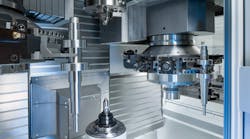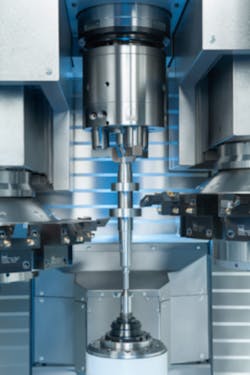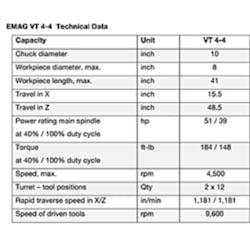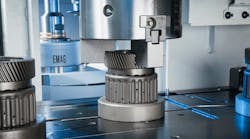According to a recent study by Roland-Berger, demand for automotive parts will expand at a rate of approximately 6% over the next two years, with competition intensifying. To gain an advantage, automotive parts suppliers must reemphasize profitability in the operations. Component production must become faster, with higher reliability for precision, to demonstrate economic viability.
That is the set-up presented by EMAG Maschinenfabrik GmbH in its presentation of a new vertical lathe, the VT 4-4, which it reported delivers at the highest level for efficiency in high-volume turning of driveline parts.
For several reasons, the production of drive and gear shafts represents a very specific task in the automotive supply chain. First, many of these parts are highly detailed and involve complex geometries that are critical to performance. For instance, high-precision gearing ensures a highly effective torque transmission within the gearbox.
Having high-precision shoulders and grooves allows for safe connectivity of components. The efficiency of a powertrain as a whole depends largely on the functionality of its shaft. These complex components are produced in batches of millions — and once the primary turning work is done the shaft should, ideally, display a geometry that is as close to final contour as possible. “Tolerance production planners look for the micrometer range of the shaft,” according to EMAG.
The machine builder developed a four-axis vertical shaft turning machine to reconcile these high-performance requirements. It now reports the VT 4-4 opens up new potential for machining components with a maximum length of 41 inches and a maximum diameter of 8 inches, with two specific advantages:
• Simultaneous machining: Machining is carried out in four axes at a maximum speed of 4,500 rpm. The process employs two turrets, each one with 12 tool stations, equipped with turning tools or driven tools, with one station reserved for the gripper.
• Automated machining: Workpiece grippers move the raw-parts to the machining area and remove the finished components — meaning that one gripper inserts a new workpiece into the machine as the other gripper removes the finished component from the working envelope.
Guarantee Cost Reduction per Finished Part
“This principle (simultaneous, automated machining) offers a great step up in performance in the production of shafts, especially in an environment that deals with large component volumes,“ explained Dr. Guido Hegener, managing director of EMAG Maschinenfabrik GmbH. “Due to the fast workpiece changeovers and powerful machining with four axes, cycle times are very short.
“Together with the integrated automation system, the process ensures that unit costs are kept to a minimum,” Hegener emphasized.
In the standard model, the VT 4-4 machine is equipped with two space-saving, recirculating conveyors that accommodate up to 28 workpieces and 28 finished components, respectively. Transfer and turnover units or robots ensure that a number of VT machines can be linked up easily, and cost-effectively.
Of particular importance to EMAG’s development engineers is the quality of the components produced. For this purpose, the machine base is made of the polymer concrete Mineralit®. It carries all technology modules: the powerful work spindle, turrets, and the tailstock. Its rigid, vibration-resistant construction guarantees an equally vibration-resistant turning process that ensures high-qualitysurfaces and highly accurate geometries. EMAG’s typical vertical alignment of the workpiece also guarantees constant process integrity, as the unhindered chip flow it offers prevents the accumulation of chips in the machining area.
“Last, but by no means least, we have also attached great importance to the ease of operation of these machines,” Hegener reported. “After all, the human factor is a very important one when it comes to productivity. We want to make it as simple as possible for the operator.”
To achieve this, all relevant components, from electrics to hydraulics, including the cooling system, are easy to access, with an intuitive user interface and clearly laid-out design.
The VT 4-4 opens up a wide range of possibilities production planners in shops manufacturing automotive drive system parts. Use of the machine is made even more economical by its compact design, with a vertical alignment that takes up very little space. Also, there is no need for additional automation because material handling is an integral part of the machine’s process.












